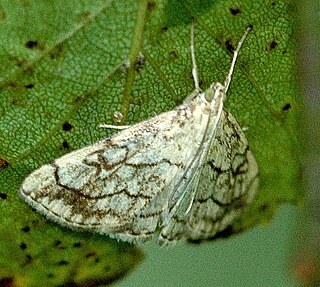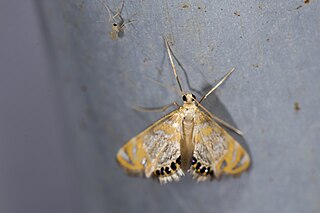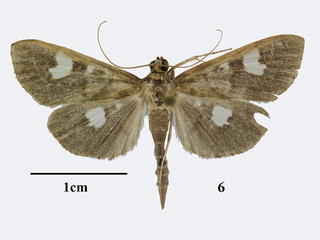
Crambidae comprises the grass moth family of lepidopterans. They are variable in appearance, with the nominal subfamily Crambinae taking up closely folded postures on grass stems where they are inconspicuous, while other subfamilies include brightly coloured and patterned insects that rest in wing-spread attitudes.

The Pyralidae, commonly called pyralid moths, snout moths or grass moths, are a family of Lepidoptera in the ditrysian superfamily Pyraloidea. In many classifications, the grass moths (Crambidae) are included in the Pyralidae as a subfamily, making the combined group one of the largest families in the Lepidoptera. The latest review by Eugene G. Munroe and Maria Alma Solis retain the Crambidae as a full family of Pyraloidea.

The Pyraloidea are a moth superfamily containing about 16,000 described species worldwide, and probably at least as many more remain to be described. They are generally fairly small moths, and as such, they have been traditionally associated with the paraphyletic Microlepidoptera.

Evergestis pallidata is a species of moth of the family Crambidae described by Johann Siegfried Hufnagel in 1811. It is found in Europe, across the Palearctic and in North America.

Cataclysta lemnata, the small china-mark, is a moth species of the family Crambidae. It is found in Europe, Morocco and Iran.
Cosmopterosis is a genus of moths of the family Crambidae.

Udea is a genus of snout moths in the subfamily Spilomelinae of the family Crambidae. The genus was erected by Achille Guenée in 1845. The currently known 216 species are present on all continents except Antarctica. About 41 species are native to Hawaii.

Nymphicula is a genus of moths of the family Crambidae.

Agriphila deliella is a species of moth of the family Crambidae. It is found in most of Europe and North Africa and from Anatolia to Afghanistan.
Tegostoma moeschleri is a species of moth in the family Crambidae. It is found in Afghanistan, Russia and Iran.

Glaphyriinae is a subfamily of the lepidopteran family Crambidae. It was described by William Trowbridge Merrifield Forbes in 1923. The subfamily currently comprises 509 species in 75 genera.

Scopariinae is a subfamily of the lepidopteran family Crambidae. The subfamily was described by Achille Guenée in 1854.

Argyria rufisignella, the mother-of-pearl moth, is a moth in the family Crambidae. It was described by Philipp Christoph Zeller in 1872. It is found in North America, where it has been recorded from the eastern United States and in the south to Arizona.
Cosmopterosis jasonhalli is a moth in the family Crambidae. It was described by Maria Alma Solis in 2009. It is found from Sinaloa, Mexico, south to Paraguay, Peru and Venezuela. It is also found Trinidad and Tobago. It is found at elevations between 50 and 900 meters. Adults are on wing year round. The larvae feed on Capparis frondosa and Capparis flexuosa.
Cosmopterosis hispida is a moth in the family Crambidae. It was described by Maria Alma Solis in 2009. It is found in Brazil.
Anania tennesseensis is a moth in the family Crambidae. It was described by Yang in 2012. It is found in North America, where it has been recorded from Tennessee.
Cangetta micralis is a moth in the family Crambidae. It is found in South America, the Caribbean and in southern Florida.
Microthyris lelex is a moth in the family Crambidae. It was described by Pieter Cramer in 1777. It is widespread in the Caribbean, Central America and northern South America. Records include Suriname, Puerto Rico and Jamaica. It has recently been recorded from southern Florida.
Penestola bufalis, the black penestola moth, is a moth in the family Crambidae. It was described by Achille Guenée in 1854. It is found in the US states of Texas and Florida, as well as on the Antilles. It is an accidentally introduced species on the Galápagos Islands. The habitat consists of coastal mangrove swamps and shorelines.

Agroterini is a tribe of the species-rich subfamily Spilomelinae in the pyraloid moth family Crambidae. The tribe was erected by Alexandre Noël Charles Acloque in 1897.











